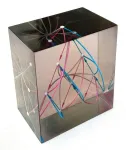(Press-News.org) The personal carbon footprint of the richest people in society is grossly underestimated, both by the rich themselves and by those on middle and lower incomes, no matter which country they come from. At the same time, both the rich and the poor drastically overestimate the carbon footprint of the poorest people.
An international group of researchers, led by the Copenhagen Business School, the University of Basel and the University of Cambridge, surveyed 4,000 people from Denmark, India, Nigeria and the United States about inequality in personal carbon footprints – the total amount of greenhouse gases produced by a person’s activities – within their own country.
Although it is well-known that there is a large gap between the carbon footprint of the richest and poorest in society, it’s been unclear whether individuals were aware of this inequality. The four countries chosen for the survey are all different in terms of wealth, lifestyle and culture. Survey participants also differed in their personal income, with half of participants belonging to the top 10% of income in their country.
The vast majority of participants across the four countries overestimated the average personal carbon footprint of the poorest 50% and underestimated those of the richest 10% and 1%.
However, participants from the top 10% were more likely to support certain climate policies, such as increasing the price of electricity during peak periods, taxing red meat consumption or subsidising carbon dioxide removal technologies such as carbon capture and storage.
The researchers say that this may reflect generally higher education levels among high earners, a greater ability to absorb price-based policies or a stronger preference for technological solutions to the climate crisis. The results are reported in the journal Nature Climate Change.
Although the concept of a personal carbon or environmental footprint has been used for over 40 years, it became widely popularised in the mid-2000s, when the fossil fuel company BP ran a large advertising campaign encouraging people to determine and reduce their personal carbon footprint.
“There are definitely groups out there who would like to push the responsibility of reducing carbon emissions away from corporations and onto individuals, which is problematic,” said co-author Dr Ramit Debnath, Assistant Professor and Cambridge Zero Fellow at the University of Cambridge. “However, personal carbon footprints can illustrate the profound inequality within and between countries and help people identify how to live in a more climate-friendly way.”
Previous research has shown widespread misperceptions about how certain consumer behaviours affect an individual's carbon footprint. For example, recycling, shutting off the lights when leaving a room and avoiding plastic packaging are lower-impact behaviours that are overestimated in terms of how much they can reduce one’s carbon footprint. On the other end, the impact of behaviours such as red meat consumption, heating and cooling homes, and air travel all tend to be underestimated.
However, there is limited research on whether these misperceptions extend to people’s perceptions of the composition and scale of personal carbon footprints and their ability to make comparisons between different groups.
The four countries selected for the survey (Denmark, India, Nigeria and the US) were chosen due to their different per-capita carbon emissions and their levels of economic inequality. Within each country, approximately 1,000 participants were surveyed, with half of each participant group from the top 10% of their country and the other half from the bottom 90%.
Participants were asked to estimate the average personal carbon footprints specific to three income groups (the bottom 50%, the top 10%, and the top 1% of income) within their country. Most participants overestimated the average personal carbon footprint for the bottom 50% of income and underestimated the average footprints for the top 10% and top 1% of income.
“These countries are very different, but we found the rich are pretty similar no matter where you go, and their concerns are different to the rest of society,” said Debnath.
The researchers also looked at whether people’s ideas of carbon footprint inequality were related to their support for different climate policies. They found that Danish and Nigerian participants who underestimated carbon footprint inequality were generally less supportive of climate policies. They also found that Indian participants from the top 10% were generally more supportive of climate policies, potentially reflecting their higher education and greater resources.
“Poorer people have more immediate concerns, such as how they’re going to pay their rent, or support their families,” said first author Dr Kristian Steensen Nielsen from Copenhagen Business School. “But across all income groups, people want real solutions to the climate crisis, whether those are regulatory or technological. However, the people with the highest carbon footprints bear the greatest responsibility for changing their lifestyles and reducing their footprints.”
After learning about the actual carbon footprint inequality, most participants found it slightly unfair, with those in Denmark and the United States finding it the most unfair. However, people from the top 10% generally found the inequality fairer than the general population, except in India. “This could be because they’re trying to justify their larger carbon footprints,” said Debnath.
The researchers say that more work is needed to determine the best ways to promote fairness and justice in climate action across countries, cultures and communities.
“Due to their greater financial and political influence, most climate policies reflect the interests of the richest in society and rarely involve fundamental changes to their lifestyles or social status,” said Debnath.
“Greater awareness and discussion of existing inequality in personal carbon footprints can help build political pressure to address these inequalities and develop climate solutions that work for all,” said Nielsen.
The research was supported in part by the Carlsberg Foundation, the Bill & Melinda Gates Foundation, the Quadrature Climate Foundation and the Swiss National Science Foundation.
END
Personal carbon footprint of the rich is vastly underestimated by rich and poor alike, study finds
2024-09-12
ELSE PRESS RELEASES FROM THIS DATE:
Tumor-induced B cell changes reveal potential biomarker for treatment response in triple negative breast cancer
2024-09-12
HOUSTON – (Sept. 12, 2024) – Researchers at Baylor College of Medicine and collaborating institutions have discovered new insights into tumor-induced B cell changes in blood and bone marrow of triple negative breast cancer patients. The findings, published in Nature Cell Biology, show two distinct patterns of B cell abnormalities that could serve as blood biomarkers for determining likelihood of response to standard-of-care chemotherapy and immunotherapy.
“Even with significant advances in immunotherapy, ...
Ehrapy: A new open-source tool for analyzing complex health data
2024-09-12
Ehrapy is intended to fill a critical gap in the analysis of health data, says Lukas Heumos, one of the main developers and a scientist at the Institute of Computational Biology at Helmholtz Munich and the Technical University of Munich (TUM): “Until now, there have been no standardized tools for systematically and efficiently analyzing diverse and complex medical data. We’ve changed that with ehrapy.” The team behind ehrapy comes from biomedical research and has extensive experience in analyzing complex scientific datasets. “The healthcare sector faces similar challenges in data analysis as ...
Ozone pollution reduces tropical forest growth
2024-09-12
Ozone gas is reducing the growth of tropical forests – leaving an estimated 290 million tonnes of carbon uncaptured each year, new research shows.
The ozone layer in the stratosphere shields our planet from harmful ultraviolet radiation – and protecting it is one of the major successes of environmental action.
But ozone at ground level – formed by the combination of pollutants from human activities in the presence of sunlight – interferes with plants’ ability to absorb carbon dioxide. Ozone is also harmful to human health.
The new study, published in ...
Study finds doctors and patients interested in environmental impact of health care decisions
2024-09-12
BOSTON – Concerns about the environmental impact of healthcare decisions rarely enter into conversations between patients and physicians. However, evidence from a new study led by researchers at Dana-Farber Cancer Institute, shows there's broad interest in changing that.
In a series of focus groups conducted in different areas of the United States, doctors and patients expressed openness to considering environmental factors when discussing treatment options. The findings, presented in a paper published online today by Nature Climate Change, suggest that educating physicians about the environmental costs of treatment ...
Five key factors predict the response of cancer patients to immunotherapy
2024-09-12
Barcelona, 12 September 2024 – Immunotherapy has transformed cancer treatment in recent years by enabling the immune system to attack tumour cells. However, only 20-40% of patients respond positively to immunotherapy, and these rates vary across different types of cancer. Predicting which patients will respond to immunotherapy and which will not is currently a highly active area of research. Numerous studies conducted so far have focused on the specific characteristics of tumours, their microenvironment, or the patient's immune ...
Trilobite fossils from upstate New York reveal “extra” set of legs
2024-09-12
A new study finds that a trilobite species with exceptionally well-preserved fossils from upstate New York has an additional set of legs underneath its head. The research, led by the American Museum of Natural History and Nanjing University in China, suggests that having a fifth pair of head appendages might be more widespread among trilobites than once thought. Published today in the journal Palaeontology, the study helps researchers better understand how trilobite heads are segmented.
Trilobites are ...
Big algebras: A dictionary of abstract math
2024-09-12
Several fields of mathematics have developed in total isolation, using their own ‘undecipherable’ coded languages. In a new study published in PNAS, Tamás Hausel, professor of mathematics at the Institute of Science and Technology Austria (ISTA), presents “big algebras,” a two-way mathematical ‘dictionary’ between symmetry, algebra, and geometry, that could strengthen the connection between the distant worlds of quantum physics and number theory.
Technical Toolkit: Symmetry and commutativity, from esthetics to functionality
Symmetry is not just a question of esthetics and equilibrium, but also a highly recurrent feature throughout the domains ...
BMI’s relation to cancer therapy mortality risks not so straightforward
2024-09-12
While being overweight increases the risk of developing lifestyle-related diseases, there is a phenomenon known as the obesity paradox where a decreased risk of death has been seen during cancer therapy. However, that paradox might not be the trend for all cancer therapies, an Osaka Metropolitan University team reports in JAMA Network Open, a publication of the American Medical Association.
Led by graduate student Mr. Yasutaka Ihara and Professor Ayumi Shintani of the Graduate School of Medicine’s Department of Medical Statistics, ...
Kids in families with too much screen time struggle with language skills
2024-09-12
Screens have become ubiquitous in our daily lives — which means they’ve also become part of children’s lives too. So what effect does this have on children’s developing brains, especially critical language skills? To understand this, scientists in Estonia surveyed the parents of more than 400 children about their screen use, their children’s screen use, and their children’s language skills. They found that parents who use screens a lot also have children who use screens a lot, and that children’s higher screen time is associated with poorer language skills.
“Our ...
Medical College of Georgia scientists searching for new treatment target for diabetic retinopathy
2024-09-12
Scientists at the Medical College of Georgia at Augusta University are searching for a new treatment target for a common complication of diabetes that can cause retinal blood vessels to break down, leak, or become blocked.
Diabetic retinopathy is a serious eye disease and a leading cause of blindness that results when diabetes’ sustained high blood sugar levels cause damage to the retina – the part of the eye that detects light – over time. That can happen in a number of ways, from inflammation to overgrowth ...





